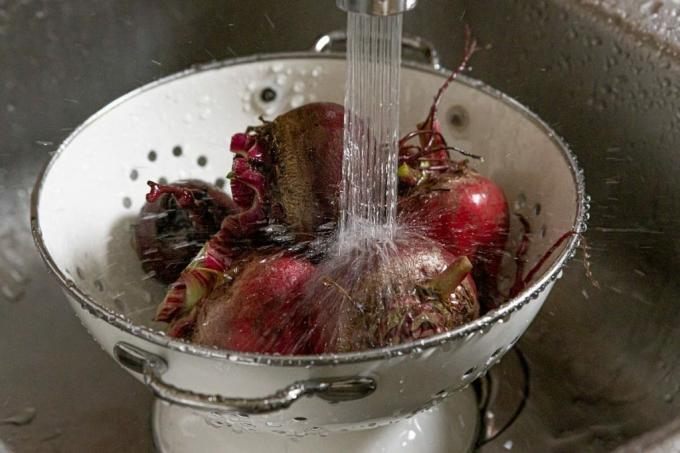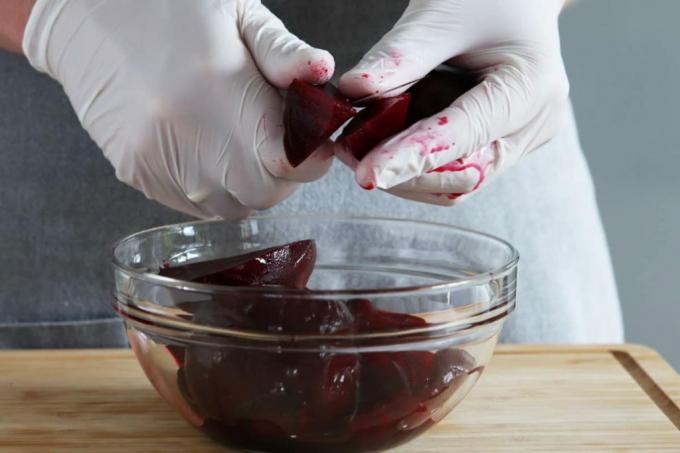
table of contents
- Required utensils
- Instructions for freezing
- frequently asked Questions
Beetroot (Beta vulgaris) impresses with its earthy, spicy aroma. The tuber can be stored in the refrigerator for about three weeks. The beetroot will keep much longer if you freeze it.
In a nutshell
- Freeze beetroot only when cooked
- peel only after cooking
- Fill in portions
- Can be kept in the freezer for up to eight months
Required utensils
To freeze beetroot, also called beetroot, you will need the following:
- Beetroot (fresh from the garden)
- soft (vegetable) brush
- kitchenknife
- large saucepan with lid
- water
- Roulade needle or skewer
- Kitchen sieve
- Freezer bags or plastic cans
- Disposable gloves
Instructions for freezing
You should beetroot only in cooked form, never raw, freeze.
1. Clean the tubers
So that the beetroot does not bleed during cooking, the leaves and peel are not removed. However, you should clean the tubers:
- Carefully remove earth residues with a soft brush
- Do not damage the shell
- Cut foliage to a minimum

2. Put in the pot
In the second step, put the cleaned tubers in the pot. Then fill it up with cold water until the beets are half covered.
Tip: Use an older pot for this in case the tubers should bleed unexpectedly.
3. Bring to a boil
- Cover the pot with the lid
- Bring to the boil on the highest setting
- Cover the pot only halfway
4. Cook
- Now reduce the heat by half
- Cook the tubers for 30 to 60 minutes

5. Carry out a cooking test
To make sure that the beetroot is firm to the bite, do a cooking test. To do this, pierce the tuber with a roulade needle or a skewer. If there is no resistance, the beetroot is done. Alternatively, you can lift a larger tuber out of the pot. If it feels soft when you press it, it is done cooked.
Tip: Exercise patience as you cook. Because every sting favors the bleeding of the tubers.
6. Strain
If the tubers are firm to the bite, you can strain them. Then rinse the beetroot with cold water.
7. Peel
Since it is inevitable that you will get red fingers when peeling, you should put on the disposable gloves beforehand. Now hold the tubers under cold running water. The shell can be easily pulled off. For stubborn spots, you can also use a small kitchen knife to peel it off.

Tip: Since juice comes out when the tubers are peeled, protect your clothes with an apron and roll up your sleeves.
8. Prepare to freeze
Once the beetroot has cooled down, you can prepare it for the freezer. It is up to you whether you cut the tubers or freeze them whole. If you want to prepare a salad later, it is advisable, for example, to cut it into slices. If the beetroot is used as a vegetable, you can cut it into small cubes now.
Tip: Leave the disposable gloves on until the beets are in the freezer or in the freezer.
9. Bottling and freezing
Finally, add the beetroot to the plastic jars or freezer bags as needed. With the latter, you should press out the excess air before sealing. This saves space in the freezer compartment. Then (or before) label the containers and place them in the freezer.

Note: You should have used up the tubers after eight months at the latest, as they will then begin to lose their taste and nutrients.
frequently asked Questions
Lemon juice is a tried and tested home remedy for red spots on the skin. If some sap stains are particularly stubborn, you don't have to worry. They go away after a few days.
Yes, that is possible. However, since these tubers only last a few days in the refrigerator, you should put them in the freezer as fresh as possible. Since they are already cooked, all you have to do is portion and fill the vegetables.
There are no special instructions for thawing. To do this, proceed as you would with any other vegetable. Since the tubers are already cooked, it won't take long to thaw them. As with further processing, make sure that no juice escapes on the work surface. Because this can lead to unsightly stains.



